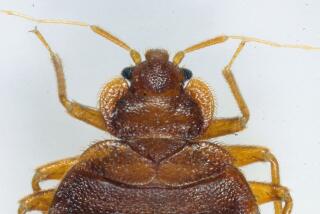They’re bad bed mates
- Share via
They were called night crawlers in German, pursuers in Portuguese and stinkers in French. In medieval Britain they were dubbed goblins, in New York they were once called red coats.
Humans have always kept close quarters with bugs (dust mites, termites and fleas come to mind), but only the bedbug, Cimex lectularius, is notorious for getting under the covers at night and biting human flesh.
Scientists believe bedbugs may have started pestering humans tens of thousands of years ago, in the Near East. The critters, enamored of warm, dry environments, probably took up residence with humans when our species started sleeping in caves.
The creatures came from bats, it’s proposed, already living in caves when humans moved in. The night fliers were plagued by a parasite that fed on them as they slept, and scientists surmise that the bat bedbug eventually evolved into a separate species, one that preferred feeding on humans.
Hard evidence for a long human association turned up fairly recently, when British archaeologists excavating an ancient Egyptian village found the oldest bedbug on record: The fossilized fellow dated back about 3,500 years, to before the time of King Tut.
Bedbugs first turned up in print in ancient Greece and Rome. The Roman philosopher Pliny described the bugs in a book on natural history; Greek playwright Aristophanes wrote the pests into several plays.
Greek doctor Dioscorides found more practical uses for the critters. To heal a wound, he suggested mixing crushed bedbugs with tortoise blood. Whether or not such cures worked, they stuck around. More than 1,000 years later, some Chinese medical practitioners advised mixing crushed bedbugs with rice or lime and sesame oil to treat injuries.
The bedbug’s love of warm, dry places may be why it took so long to move beyond Africa and the Mediterranean. The earliest English mention of bedbugs dates to the late Middle Ages, and even then the insects had limited reach. They only bothered the well-to-do, the ones lucky (or unlucky) enough to have warm, dry homes.
As the human population grew, and got better at building homes, bedbugs plagued more and more people. Infestations in rapidly industrializing cities in the 1800s led a few entrepreneurs to figure they could make a buck off of the bugs. The first professional exterminators were born, dousing homes with a mercury compound and alcohol to kill off infestations.
Many people opted for simpler, (and less toxic) approaches: periodically pouring boiling water or oil onto their floors to kill the bedbugs living in the cracks and crevices, or lathering furniture legs with petroleum jelly to prevent the bugs from crawling onto stuffed chairs and mattresses.
A stronger weapon came along in the 1940s in the form of the pesticide DDT. In hospitals, homes and army barracks, mattresses and pillows were sprayed until dripping wet, and the bedbugs disappeared. But DDT wasn’t the only reason why bedbugs went into retreat. Vacuum cleaners, washing machines and dryers are all enemies of the fragile pest. And as home decor became more streamlined, the bugs had fewer crevices and drapery folds in which to hide.
But respite from bedbugs has turned out to be temporary. In recent years, they’ve come back with a vengeance -- to homes, college dorms, movie theaters, airplanes, cruise ships and even five-star hotels. Experts blame the abandonment of pesticides (DDT was banned in the 1970s) and increased travel: Bedbugs can survive six months without eating, making them ideal suitcase hitchhikers.
The bugs have surfaced in a new world in which they’ve spawned panic -- and lawsuits. Parents have sued camps and schools, tenants have sued landlords, guests have sued hoteliers.
But there’s one group that hasn’t been complaining: exterminators, who, to an extent, owe their livelihood to the critters in the first place.





